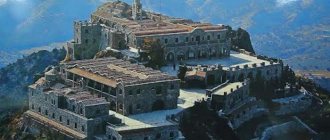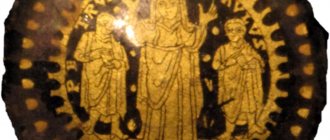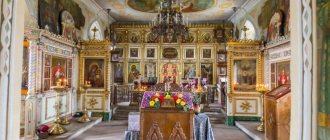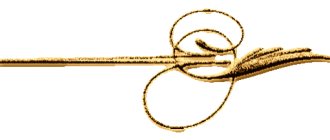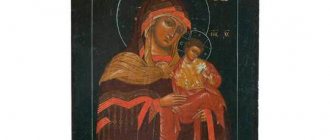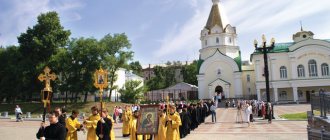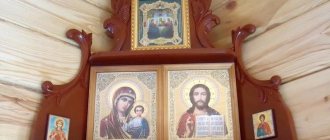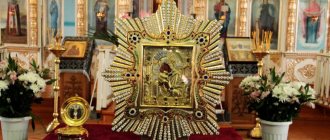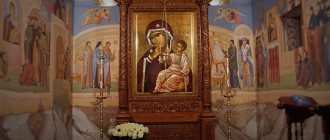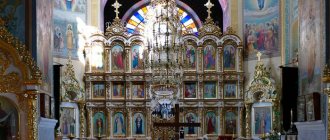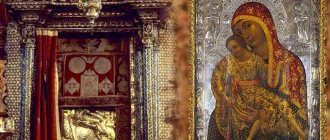This now lost shrine is known to believers with the name of the man who prayed before it in the last minutes of his earthly life, before an angry crowd broke into the monastery, looking for Schemamonk Ignatius, the former prince Igor.
Iconography: Igorevskaya Icon of the Mother of God Dates: XX century. 2000 Icon painter: Adaev Gennady Anatolyevich. Material: Wood, pavolok, gesso, tempera, gold. Dimensions of the icon: height 43 cm, width 32 cm. The icon shows a shoulder-length image of the Mother of God with the Child pressing his cheek to Her cheek. Inv. No. KP-20802. © Omsk Regional Museum of Fine Arts named after M.A. Vrubel.
History of the icon
The distant year 1146. More than 150 years have passed since the adoption of Christianity by Russia, there are already churches in the cities, Divine services are being performed. But much more difficult than accepting a creed is an internal change in life. It is difficult to become a Christian in more than just name. It’s a hundred times more difficult if you are a prince, which means you find yourself amidst the storms of political life, the struggle of ambitions that even lead to bloodshed. The Church calls rulers who have withstood the terrible test the faithful. And some of them are martyrs. Among them is young Igor Olgovich, a descendant of Prince Yaroslav the Wise.
History of the shrine
The origin of the icon is closely connected with the fate of the Kyiv prince Igor from the Olgovich family. The martyr lived in those distant times when Rus' was mired in princely wars for the right to own lands. Unwittingly, Igor became a participant and a victim in the struggle for power. The prince inherited the throne from his brother Vsevolod, whom the people of Kyiv disliked for his pride and disrespectful attitude towards mere mortals. The principality was under Igor's rule for only two weeks. After this, the people decided to rebel so that Izyaslav Mstislavovich (grandson of Monomakh) would ascend the throne instead of Igor. The boyars raised people who did not like the Olgovichs to revolt. In fact, Igor became an innocent victim of the crowd and circumstances, since during his short reign he did not manage to anger the Kiev people with anything.
As a result of the clash, the Kiev army went over to Izyaslav, betraying its own ruler. After the failed battle, Igor hid in the swamps for several days. But he failed to escape his pursuers. The prince was tracked down and sent to an ice log house, where terrible conditions awaited him. Naturally, the former ruler became seriously ill. They decided to let him go, realizing that he would die soon anyway. After Igor’s release, he was transported to the Fedorovsky Monastery. Soon within its walls the prince recovered and decided to take monastic vows.
Photo 1. Igor's Icon of the Mother of God.
According to historical chronicles, Igor has always been a deeply religious person. This probably prevented him from retaining power in his hands. Even in his youth, he often had long conversations with the venerable elders. Therefore, once in the monastery, he decided without hesitation to take monastic vows and serve God.
Having accepted the schema, Igor remained in the monastery as a monk. Since then, they began to call him Ignatius (and according to other sources, Gabriel). Within the monastery walls, the prince read a lot of spiritual scriptures and prayed.
At the same time, his comrades continued to fight for the opportunity to rule. Wanting revenge, the people of Kiev decided to deal with Igor at the assembly. During a service in the church at the monastery in 1147, when the prince said a prayer before the image of the Mother of God, angry people broke into the church and killed the monk. The prince's body was then dragged through the city streets.
The attempts of the abbot of the monastery could not save Igor from imminent death. The people did not understand the words of the confessor. The opposition of Vladimir and Izyaslav did not save the prince either. From that time on, the icon in front of which Igor prayed in the last minutes before his death began to be called Igorevskaya.
Educating the Soul
When encountering inexplicable phenomena, a person may become confused, since the mind is accustomed to giving its own interpretation to everything. But not everything can be explained - even scientists admit this. In this case, prayer will help you gather your thoughts. Countless numbers of them sounded at the Pochaev Icon, many received a wonderful response.
- Vladimir Icon of the Mother of God
- Icon of the Mother of God “Unexpected Joy” - here
- Icon of the Mother of God Look at Humility -
What else do Orthodox Christians pray for at the Pochaev Icon?
- About healing from body ailments, including problems with hearing and vision.
- About protection from enemies in any situation.
- About ending hostility.
- About strengthening faith, healing the soul from the demons of despondency.
Description of the icon
According to icon painters, the prototype for the creation of the shrine was another icon. She is known as Our Lady of Tenderness. Experts believe that the shrine was painted at the turn of the 11th and 12th centuries. The icon of Our Lady of Vladimir was created in the same style.
Photo 2. Igor's relic.
On the shrine the baby is depicted in the arms of the Virgin Mary. He hugs her with one arm, pressing his cheek to hers. At the same time, the face of the Son of God is very serious. The face of the Mother of God is very sad, because she knew about the fate of Jesus.
Experts speak of great similarities between the two shrines : Vladimir and Igorevsk. But the latter has its own characteristics:
- The Mother of God's gaze is not directed at standing people. He looks like a contemplative praying person.
- Another distinctive feature is the baby's left hand, with which he hugs his mother. It is absent from the Igorevskaya relic, but is depicted on the prototype.
The shrine is decorated with a silver chasuble with gilded ornaments. There is an inscription on it stating that the icon belongs to Prince Igor.
Even people who are calm about religion cannot look at the ancient shrine indifferently.
Where to hang
According to the traditions of the Orthodox Church, the altar in the temple is located on the east side. It is not always possible to place an iconostasis in such a place in the house. Then they choose the most honorable and open place.
The Pryazhevskaya Icon of the Mother of God can be kept either in the main iconostasis or hung separately. The main thing is that the image is clearly visible, there is free access to it and the possibility of complete privacy.
It is best to choose the wall of the room for the icon, which is located in the right corner opposite the door. If the image is attached vertically, you need to provide a special shelf for candles under it. At home, it is better to use special candlesticks that protect from open fire or lamps.
It is important to ensure that there is a spacious approach to the icon, and that there is nothing distracting during prayer. There should be no decorative interior decorations, posters, paintings, etc. next to the image.
In a word, everything that does not relate to prayer
There should be no decorative interior decorations, posters, paintings, etc. next to the image. In a word, everything that does not relate to prayer.
The icon can be hung in any room where household members are accustomed to holding a family prayer service.
It is especially important to place the image where the sick person lives, in need of the help of the Most Holy Theotokos. If a person is limited in movement, it is worth placing the icon so that it is clearly visible without any effort, and a person suffering from an illness of the musculoskeletal system can always pray, without outside help
Where is the icon
The oldest icon was transported to the Assumption Cathedral, located in the Kiev Pechersk Lavra. It was installed near the royal gate near John the Theologian. It was located at this location until the beginning of the 20th century. After the revolution, the shrine was taken out of the country several times. However, miraculously the image returned to its native place.
Unfortunately, after the Nazi occupation of Kyiv, the trace of the icon was lost forever. To this day, its whereabouts remain a mystery. However, over the centuries of its presence on Russian soil, many copies were created. The most valuable of them is the icon located in the Assumption Cathedral in Moscow.
Photo 3. Igor’s image was in the Lavra before the start of the war.
The memory of Prince Igor is revered on June 5. On this day, a solemn prayer service is held annually near Igor’s shrine.
The meaning of the holy image
Most icons of the Mother of God fit into several basic types. In this case, it is “eleusa” (“merciful”) - although the name is not entirely accurate and is one of the epithets awarded to St. Mary, it switched to an iconographic scheme. You can recognize it by its main features:
- The Baby and His Mother touch each other's faces. This opens up a very personal communication between them.
- Mary's head bows towards her Son.
- Christ hugs the Virgin Mary with his left hand.
- The image is half-length.
The Pochaev version is also distinguished by the fact that the Mother of God in her right hand holds a cloth with which the Child is entwined. The miraculous icon is also known for its precious frame, which is comparable in size to the image itself. The faces seem to be surrounded by a golden glow.
The faces of saints are present on the icon:
- Martyr Stephen - it is believed that he was the first to be killed for the Christian faith;
- Reverend Abraham - in history there were a lot of ascetics with this name, perhaps this was Abraham of Rostov, who crushed idols and converted several pagan tribes to Christianity;
- Prophet Elijah is the most famous Old Testament prophet, the patron saint of paratroopers and pilots, also revered in Islam and Judaism. Known for being taken to heaven alive;
- Martyr Mina - the first Florentine martyr;
- Great Martyr Catherine - lived in the first centuries of Christianity, was executed after refusing to marry the Roman emperor, having decided to devote herself to Christ;
- St. Irina - put to death along with two Christian sisters in the 4th century;
- St. Paraskeva is one of the first martyrs who died with her entire family during the reign of Nero.
The meaning of the composition of the Pochaev Icon is deeper than it might seem at first glance. Of course, an affectionate Mother and a loving Son are shown here. Any person can “try on” one of the roles - everyone was a child, even if they themselves did not become parents. But it also depicts the ideal relationship between God and the human soul.
When they pray at the icon
As we know from history, insight and a new understanding of his destiny did not save Igor from death. Although the former ruler became a monk at the monastery, the Kiev people dealt with him. Therefore, they pray in front of the icon when a difficult life situation arises. In addition, you can pray if your loved ones are in danger. People come to the shrine:
- During illness.
- With a request to protect the house from fires and robberies.
- For reconciliation with relatives after a strong scandal.
- In times of despair, despondency and sorrow.
Orthodox people consider the icon miraculous.
Prayers have the greatest power on the day of memory of Prince Igor. At this time, you can rid your soul of passions.
It is read that in the image the Mother of God is the personification of the church. And the contact of the baby with the mother is interpreted as a connection between the human and divine worlds. The ancient icon indicates to those praying that genuine faith and prayer can open the soul before the Lord.
Prayer
To whom will I call, Lady, to whom will I resort in my sorrow? To whom shall I bring my tears and sighs, if not to You, Queen of Heaven and earth? Who will pluck me from the mire of sins and iniquities, if not You, O Mother of the Belly, Intercessor and Refuge of the human race? Hear my groaning, comfort me and have mercy in my sorrow, protect me in troubles and misfortunes, deliver me from anger and sorrow, illnesses and illnesses and from enemies visible and invisible; pacify the enmity of those who oppress me, so that I will be delivered from slander and human malice; So, free me from my flesh and vile customs. Cover me under the canopy of Your mercy, so that I may find peace and joy and cleansing from sins. I entrust to myself your maternal intercession: be my Mother and hope, protection, and help, and intercession, joy and consolation, and a quick Helper in everything. O wonderful Lady! Everyone, flowing to You, will not leave without Your all-powerful help. For this reason, I, unworthy, am running to You, so that I will be delivered from sudden and cruel death, gnashing of teeth and eternal torment, and I will be honored to receive the Kingdom of Heaven and You in my heart the river of the heart: Rejoice, Mother of God, our zealous Representative and Intercessor, in eyelids of centuries. Amen.
Copies of icons
At the beginning of the 20th century, the artist Shinkarenko painted a copy of the relic on the instructions of the Committee for the Trusteeship of Russian Icon Painting. Thanks to this image, contemporaries have the opportunity to have an idea of the iconography of a distant era.
At different times, many copies were created, which were distributed to different regions of the country. A smaller image of the Igorevskaya relic was sent to Vladimir. People know the icon as the Vladimir icon.
It is worth noting that the tradition of creating smaller images is rooted in the depths of history. Typically, copies were created with maximum accuracy. So in the Vladimir image you can see the characteristic tilt of the Head of the Mother of God, the same pose of the baby, similar silhouettes. Of course, the copies also had some differences, since they were created by living people.
Photo 4. Over many centuries, craftsmen have created many copies of the relic.
Experts believe that the Igor Icon was created in the style of Greek writing. However, it is not as ancient as legend says. The relic, in terms of its writing, resembles the Vladimir and Iveron-Athos images.
Among the famous Igor icons, the earliest is considered to be a relic dating back to the second half of the 16th century. It is believed that it was created in Moscow during the lifetime of Metropolitan Macarius. In those days, copies of many famous icons were painted in his workshops. It is noteworthy that the craftsmen observed exact dimensions and all the principles of iconography.
Another copy was previously dated to the second half of the 16th century, but now experts are clarifying the current time of writing.
The Igor Icon is mentioned several times in the chronicle of Sergei of Radonezh. According to experts, one of the copies could be a family heirloom of Radonezh, who was a native of the Rostov lands. It is known that in the Assumption Cathedral of Rostov there was an icon given by Vladimir Monomakh. According to legend, the image was created by the Monk Alypius of Pechersk.
What does “Burning Bush” help with?
As mentioned above, the icon protects, first of all, from fires and lightning. But her power does not end there, because before us is the image of the Most Pure Virgin, that is, the eternal Intercessor of all humanity.
They pray to the “Burning Bush” for:
- rescue from natural disasters;
- humility of anger (both one’s own and directed at the person praying);
- healing from physical and mental illnesses;
- getting rid of “love fever” and returning spouses to their families;
- salvation of the soul and deliverance from sinful thoughts.
Miracles associated with the icon
In Russia, the most famous miracle is the one that led to the establishment of the Church of the Burning Bush icon in Khamovniki in the 17th century.
Boyar Dmitry Koloshin, stirrup of Tsar Feodor, loved to pray to the “Burning Bush” icon, hung in those years in the Faceted Chamber of the Kremlin. Somehow envious people slandered the boyar, and the royal wrath fell on the eager one. In fear, Dmitry Koloshin turned to his favorite image for help. The Heavenly Intercessor appeared to the monarch in a dream, and he had mercy on the innocently slandered stirrup.
In gratitude and in memory of the miracle revealed, Koloshin founded the Church of the Burning Bush Icon of the Mother of God in Khamovniki. The icon, recognized as miraculous, was also transferred there.
Another miraculous icon is located in a small temple in the village of Suksun, Perm Territory. There she appeared in the 17th century in a completely inexplicable way. It was discovered by a local fisherman: he saw the icon floating along the river.
The fisherman was a Muslim, so he decided not to touch the Christian image, but the next day the icon sailed to him again. The man saw God’s intention in this and took the image to the temple. There the icon was hung in its proper place, a prayer service was served, and it began to work miracles.
In Ulyanovsk there is also a temple of the Burning Bush icon. The image of the Mother of God was brought there from Athos a little over a century ago, and almost immediately it began to perform miracles of healing. They say that even people far from Christianity received help from him.
Icon "Burning Bush" in Ulyanovsk
Another image known for miracles is located in the city of Slavyansk, in the Donetsk region, in Ukraine. Its appearance is associated with a series of fires that gradually destroyed the city in 1822. He would have burned out, but a vision revealed to the parishioner Belnitskaya helped him overcome his misfortune.
The Ever-Virgin visited the townswoman in a dream and ordered her to create the image of the “Burning Bush.” Belnitskaya shared this with the archpriest, the icon was painted, and a prayer service was served before it. And soon the arsonist was discovered, who turned out to be the girl Mavra, a local madwoman.
